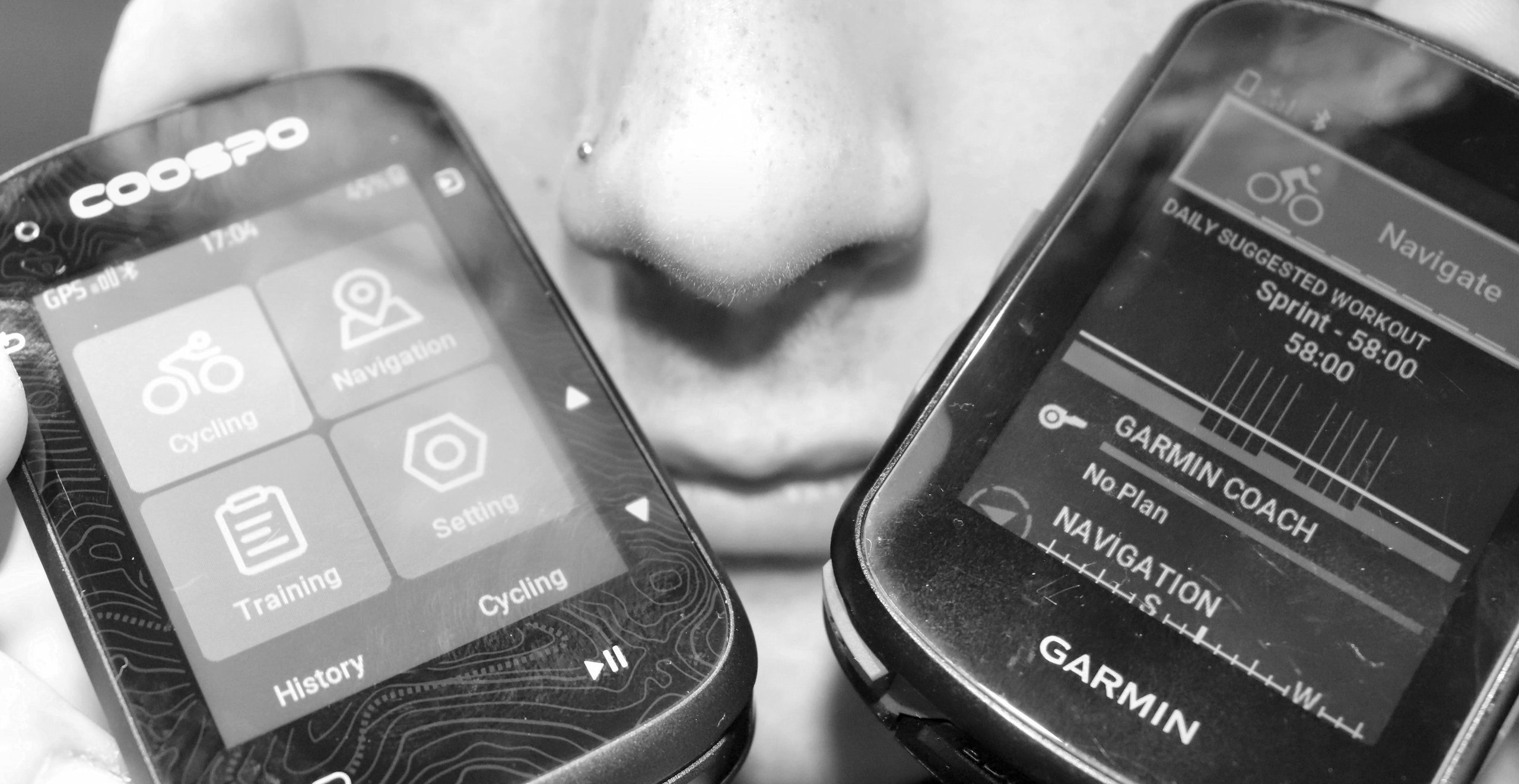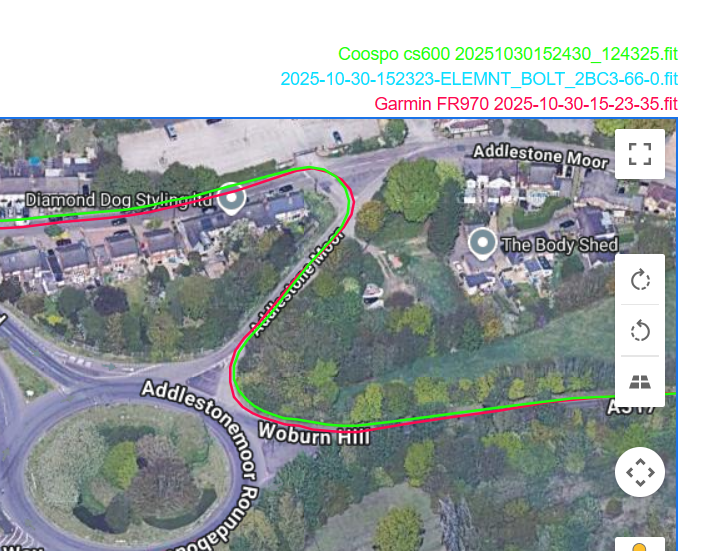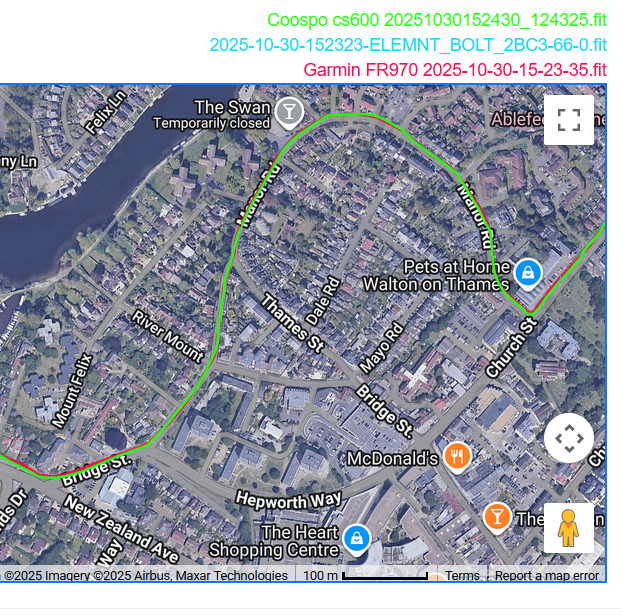COOSPO CS600 Review – Incredible Value GPS Bike Computer
It looks like a Garmin, feels like a Garmin, and even smells like a Garmin, but is this sub-$150 bike computer anywhere near comparable to a Garmin that sells for at least twice the price?
The quick answer is that obviously it isn’t as good. However, the CS600 will do a perfectly adequate job for most cyclists, and if your cycling buddies think you have a Garmin because it looks similar, what’s not to like? Here are my thoughts after a couple of weeks riding with it.
Initial Assessment
I wanted to get the CS600 paired to my HRM and power meter and do a quick couple of laps of the local park. The app download and setup were easy. The pairing of my sensors was easy. Changing the screen to show a power field took a tad longer, and finding where to pair the app to Strava took another minute. I was thinking ahead!
Now for the annoying bit of putting on a new bike mount. Oops. No need. It fitted the Garmin one I already had. That’s a bonus 5 minutes saved.
The button+touchscreen interface is intuitive, with the buttons working similarly to those on my Garmin, but a far simpler set of menus and options. I’m always careful if I say ‘intuitive’ as it depends on what you’re used to. The only unintuitive bit was saving the workout at the end.
The device looks good despite the overtly white COOSPO branding on the face. It is one of several brands that seem to be directly copying the look of the Edge 530/540…perhaps why Garmin has changed the look of its latest models. Anyway, it looks good as a piece of hardware. The homescreen software display is basic and not so great to look at, but once in the workout pages, it’s pretty much the same as any other bike computer.
It feels very lightweight; the buttons and touchscreen work well enough.
Unlike my Wahoo, it starts very quickly; I assume it’s waking up rather than entirely rebooting, as it takes less than a second.
The buttons are a little bit too recessed for use with gloves, and the screen is a little temperamental when wet; nothing too bad.
When it comes to the map, it looks a bit dull and shows basic details, but it is more than adequate for on-road routing. A nice touch is the single button that toggles through various map zoom levels, a clever little innovation. The map doesn’t seem to have any pinch zoom or pan facility, which is a shame.
The Value Proposition
Coospo is a challenger brand established a decade ago and has been getting more serious about bike computers over the last 3 years. It has released several models, and the CS600 is the top of the range. Its range is entirely budget-focused, and the core proposition for the CS600 is a high ratio of advanced capabilities to cost. Ie some advanced features at a far more affordable price.
| Launch Date | Key Features | |
|---|---|---|
| BC107 | June 2022 | GPS/Beidou; 2.3″ FSTN; ANT+ core sensor support (HR, Cadence, Speed, Power); claimed 28h battery; core metrics speed/distance/elevation/gradient/calories; Strava upload; No Navigation. |
| BC200 | October 2020 | Adds GLONASS and 2.6″ LCD; adds Bluetooth sensors; configurable fields; claimed 36h battery; advanced metrics (FTP, TSS, NP); |
| BC26 | June 2024 | Entry-level with limited features |
| CS300 | May 2024 | Deeper features than BC200 |
| CS500 | Q3 2024 | Adds maps and TBT routing, 45h battery; Radar support; Workouts/Training Modes; Strava/TrainingPeaks sync. |
| CS600 | Sep 2025 | 2.4″ Full-Colour TFT Touchscreen; Full GNSS (GPS, GLONASS, Galileo, Beidou, QZSS); auto alert/lap/pages; claimed 36h battery; 8GB storage; 9 sensor types; e-bike/light support; customizable display; richer map navigation; IPX7. |
Technical Deep Dive: Hardware and Full GNSS Accuracy
Garmin recently released its latest Edge 550 with a low 12-hour battery life. This is a crazy move; unless you charge the battery after every ride, there’s a decent chance you’ll suffer from persistent range anxiety. With the Coospo CS600, you get a claimed 36-hour battery life – excellent!
As mentioned earlier, the interface is mostly intuitive to use. But its screen is also readable in most light conditions as it has a transflective LCD display, meaning it uses and reflects some ambient light to aid readability and extend battery life.
I tested some of the built-in sensors’ accuracy, including a barometric/GNSS fused altimeter and the GNSS chipset – Coospo unusually use a UBLOX chipset, so I dug a bit deeper on that one.
GNSS Accuracy
I’ve tested the CS600 over about 100 miles of easy to medium difficulty road GNSS conditions, and its GNSS performed as accurately as I would expect any bike computer to perform in 2025.
The 4 examples from one ride, below, show the Coospo in GREEN and the red from the Garmin shows through wherever there is a deviation. The deviations are minor to the point of being irrelevant and in line with the other rides. Check out the tracks on the bends, bridges and near buildings:
SPEED and DISTANCE Accuracy
Speed and distance accuracy are the same if you assume the device can measure time correctly.
There are very slight differences in the overall ride distances and speed, as shown on the chart below. This compares speed/distance from an identical GNSS source. There is nothing too concerning here but they should be the same.
ELEVATION Accuracy
There appears to be an issue with elevation, which clearly drifts during the course of a ride. This can happen with a shift in barometric pressure, but that was not the case with this short ride.
The CS600 will allow a manual calibration at the start of a ride; this wasn’t necessary in my case – it started out great.
Power & Cadence Recording
Power and cadence came from only one source – the fantastic Favero Assioma PRO RS power pedals, and thus each metric should be the same when compared across all devices. they weren’t the same.
Coospo underreported by 1% meaning it lost some data, somewhere, somehow. That’s wrong, but small in scale. Cadence is an essential input to the power calculation ie force X cadence=power. so perhaps it was a cadence issue confounding the power? IDK, that’s over the the brand to investigate.
As you can see from the cadence chart, there are minor discrepancies which should not be there.
Coospo CS600 Key Hardware Specs
The hardware specs are very similar to those of other brands. What stands out is the battery life, low (normal)weight, full GNSS chipset, and full BLE/ANT+ sensor support. All are important hardware features.
| Display Type & Size | 2.4” Colour Touchscreen / Transflective LCD, sunlight readable |
| Physical Dimensions | 84x53x18 mm |
| Weight | 69g |
| Battery Life (GPS Mode) | claimed 36 hours |
| Charging Time | 2 hours |
| Storage | 8 GB |
| Positioning System | Full GNSS (GPS, BDS, QZSS, GLONASS, and GALILEO) UBLOX chipset |
| Waterproof Rating | IPX7 |
| Connectivity | ANT+ & Bluetooth 5.0 (BLE) |
| Charging Interface | Type-C |
| Max Displayable Parameters | 150+ |
| Navigation Feature | Map navigation |
| Buttons | 6 |
Enhanced Training Suite and Ecosystem Integration
For the price, Coospo has an impressive enough training suite. For example, it tracks advanced power metrics like FTP, IF, NP and TSS, and can link to the two most widely used external platforms – Strava and TrainingPeaks via the Coospo Ride app.
Sensor compatibility is surprisingly good, and it supports everything I need – smart trainer, smart RADAR, power meter, HRM, Di2, and more.
As mentioned elsewhere, the maps are good enough for the occasional navigator. However, you face a further issue: you typically must manually import all routes you want to follow via the Ride app. If you follow routes infrequently, that’s OK; if not, it will annoy you.
Where the ‘Great Value’ Argument Slightly Falls Down
You might see a Garmin Edge 530 for $300 or a newer Edge 540 for $345. Those clearly are two or three times the price of Coospo.
Yet even the older Edge 520, if you can find one new, would be better than the CS600 and likely cheaper still. Then you might also stumble across Garmin’s more affordable and smaller Edge 130 Plus for $199. Still more expensive and also a smaller format.
Let’s say you can get hold of a new, older model Garmin for $150 in BFCM sales. That’s better than the Coospo and perhaps still within your budget. Coospo are still cheaper.
Q: Buy Second Hand?
A: No, don’t buy a second-hand Garmin as its battery will have deteriorated.
Who will buy Coospo CS600?
The CS600 will suit riders of any level of fitness.
However, where it lacks is in more niche features. Thus, riders with specific or complex training and navigation needs might miss what they consider a key feature – such as a ClimbPro-like feature or automated route synchronisation from Strava/Komoot/RWGPS.
On the other hand, this is a competent …even great little bike computer for the beginner who thinks they could become a more serious cyclist over the coming years. With an impressive battery life, what’s not to love?
Coospo CS600 Review Summary
-
Price - 95%
95%
-
Apparent Accuracy - 80%
80%
-
Build Quality & Design - 70%
70%
-
Features, Including App - 70%
70%
-
Openness & Compatability - 60%
60%
A good budget choice for the feature-conscious cyclist at any level of ability.
Coospo is a fledgling brand and not widely known in the upper echelons of cycling tech users. However, it certainly is generating awareness in the market’s competitive, budget end.
It’s hard to predict the future viability of any company, but I suspect Coospo have what it takes to survive over the coming years. The good side is that its app and wider ecosystem capabilities will likely improve as the company grows. While the next generation of their bike computer might get more advanced features like ClimbPro, even the CS600 you’re looking to buy should benefit from third-party integrations added to the ecosystem – like for Strava route syncing. This means that there’s a good chance that CS600 will get even better.
I’ve relayed some minor accuracy concerns to the brand. They need tweaking, and I don’t see the level of issue being a barrier to you buying one. Your strava segments and workouts will look fine!
Pros
- Great Value: Features normally found on more expensive bike computers
- Battery Life: 36-hour battery life is very good
- Full GNSS System Support: Accurate tracks, distance and speed
- Sensor Compatibility: power meters, smart trainers, RADAR, and more
- Intuitive Operation
Cons
- Elevation Drift
- Minor Data Loss: power/cadence observed in testing.
- Basic Navigation: Maps are dull and basic; lack pinch-zoom/pan and automated route sync with services like Strava or Komoot.
- Physical Issues: Buttons are a bit recessed for use with thick gloves, and the screen can be temperamental when wet.
















